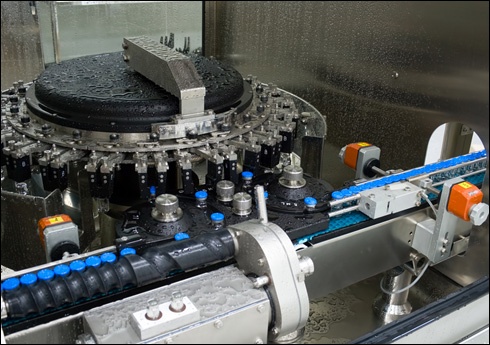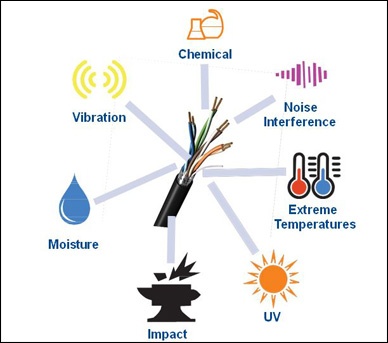When to Use Industrial-Grade Instead of Office-Grade Ethernet Cable
It’s not surprising that Ethernet has migrated from office environments to industrial environments. After all, the use of open, standards-based communication technology has made it easy to connect the plant floor to enterprise systems resulting in many business benefits. And, the adoption of common computing and networking platforms has reduced costs such as network maintenance, administration and labor expenses.
There is a downside of Ethernet standardization though --too often office-grade cable is being used in industrial and harsh environments. This jeopardizes uptime and safety and can cost organizations far more than what they “saved” by installing commercial cable in demanding environments in the first place.
What are the applications that require industrial-grade Ethernet cable versus the office-grade Ethernet cable used in enterprise networking? There are more of them than you might think. Let’s review the situations where Total Cost of Ownership (TCO) is reduced by specifying industrial-grade cable for Ethernet network infrastructure.

Machinery that gets washed-down, like this equipment in a pharmaceutical plant, requires industrially hardened Ethernet cable with the right industry approvals.
Traditional Industrial Applications that Require Industrial Ethernet Cable
The first category of application that benefit from industrial-grade Ethernet cable is traditional manufacturing and process control operations such as:
- Discrete manufacturing of every kind
- Food and beverage processing
- Chemical processing
- Pharmaceutical manufacturing
- Pulp and paper mills
- Power generation plants, wind and solar farms
- Power grids and substations
- Oil and gas upstream, midstream and downstream processes
- Water and wastewater facilities
- Transportation systems including airports, subway and light rail systems, shipyards
- Military bases and critical infrastructure such as tunnels, dams and bridges
Consistent and reliable signal transmission performance is challenged in these applications by conditions such as extreme operating temperatures, UV exposure or contact with water, oil or other chemicals. There may also be mechanical hazards, machine vibration, power or voltage fluctuations or electromagnetic interference (EMI).
For example, in food and beverage processing, networking components undergo regular, high-intensity cleanings to meet stringent hygiene requirements. This involves the use of high pressure water and caustic cleaning chemicals.
Now consider the use of highly automated equipment, such as packaging lines. In this application, the demands include tight spaces, elevated levels of electrical noise, prolonged vibration and vigorous torque.
One more case is the chemical processing industry where Ethernet cable must withstand outdoor conditions such as sunlight, extreme temperatures, rodent gnawing and rainfall.
The Risks of Using Office-Grade Ethernet Cable for Industrial Applications
The intended habitat of the Ethernet cable used in enterprise networking applications is the temperature-controlled, clean, quiet, protected, indoor environment. What are you risking when you install office-grade Ethernet cable in industrial environments?
1. Uptime
Preventing signal transmission problems is a major factor in ensuring consistent and dependable network uptime and productivity. Each second of downtime equals money lost – through lower production, costly repairs or maintenance and worker safety expenses. Indirect costs include delayed downstream processes, system shut-down and start-up costs and loss of service availability to customers.
2. Safety
Optimum safety is critical to protect people and processes in all industrial operations. These applications demand fail-safe reliability, including signal transmission reliability, to avoid accidents and environmental incidents.
3. 控制
Industrial facilities rely heavily on their automation, instrumentation and control data communications to relay signals between devices, machinery and the control system. This communication triggers events and functions on a very specific and pre-determined schedule, with little or no margin for error. Continuous monitoring, management and control drive operational efficiencies and potential cost savings.
The bottom line is that Ethernet cable designed and intended for industrial environments delivers the functionality, uptime, safety and control required by industrial applications. Office-grade Ethernet cable does not.

If the cable in your application will be exposed to any of these environmental conditions, make sure to use industrial-grade Ethernet cable rather than office-grade Ethernet cable.
Lesser Known Industrial Applications that Require Industrial-Grade Ethernet Cable
Another category of application where hardened industrial-grade Ethernet cable should be evaluated is wherever you have Ethernet communication systems with outdoor cable uses, even if the cables are underground. Examples include:
- Traffic systems that include sensors in the pavement at stoplights
- Automated gas station pumps and video surveillance systems
- Intelligent parking meter systems
- Campus security systems that include cameras and call boxes
The harsh conditions for these applications include sunlight, temperature extremes, humidity, dust, rainfall, grit and sludge. Vehicle traffic may also expose cables and equipment to oil, gas and caustic fumes.
While the consequences of downtime with these applications are not quite as acute as they are with traditional industrial processes, it is still expensive. Given the difficulty and cost of replacing faulty or worn cable, the TCO for these systems is usually lower when industrial-grade hardened cable is used in the initial implementation.
Industrial-Grade Ethernet Cable Maximizes Uptime and Minimizes TCO
The most effective – and cost-effective – way to ensure long-term network infrastructure functionality and reliability is to choose the right Ethernet cable for the application. Cable issues are often at the root of network performance problems yet they can also be hard to diagnose and costly to fix.
Whether you are specifying cable for a traditional industrial application or a lesser known one, be sure to ask yourself “How harsh is the environment for my project?” Then select the industrial-grade Ethernet cable that meets the project requirements and has the right industrial approvals. This approach maximizes network uptime and minimizes TCO.
